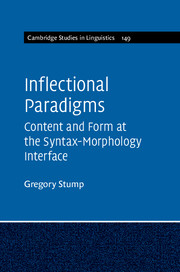Book contents
- Frontmatter
- Dedication
- Contents
- List of figures
- List of tables
- Acknowledgements
- List of abbreviations
- List of symbols and operators
- Introduction
- 1 What are inflectional paradigms?
- 2 Canonical inflectional paradigms
- 3 Morphosyntactic properties
- 4 Lexemes
- 5 Stems
- 6 Inflection classes
- 7 A conception of the relation of content to form in inflectional paradigms
- 8 Morphomic properties
- 9 Too many cells, too few cells
- 10 Syncretism
- 11 Suppletion and heteroclisis
- 12 Deponency and metaconjugation
- 13 Polyfunctionality
- 14 A theoretical synopsis and two further issues
- References
- Index
6 - Inflection classes
Published online by Cambridge University Press: 18 December 2015
- Frontmatter
- Dedication
- Contents
- List of figures
- List of tables
- Acknowledgements
- List of abbreviations
- List of symbols and operators
- Introduction
- 1 What are inflectional paradigms?
- 2 Canonical inflectional paradigms
- 3 Morphosyntactic properties
- 4 Lexemes
- 5 Stems
- 6 Inflection classes
- 7 A conception of the relation of content to form in inflectional paradigms
- 8 Morphomic properties
- 9 Too many cells, too few cells
- 10 Syncretism
- 11 Suppletion and heteroclisis
- 12 Deponency and metaconjugation
- 13 Polyfunctionality
- 14 A theoretical synopsis and two further issues
- References
- Index
Summary
Languages with rich inflectional morphology frequently exhibit inflection-class systems, in which the same morphosyntactic property sets are realized differently in the inflection of stems belonging to the same syntactic category but to distinct inflection classes. Drawing on the notion of canonical inflection classes proposed by Corbett 2009 (Section 6.1), I highlight three facts about inflection classes that have important implications for an adequate theory of inflection: These are the fact that inflection classes may be global or segregated (Section 6.2), the fact that inflection classes are classes of stems rather than classes of lexemes (Section 6.3), and the fact that inflection classes are often most easily distinguished by their patterns of stem formation and stem alternation (Section 6.4).
Canonical inflection classes
Corbett (2009) proposes a list of canonical characteristics of inflection classes. These are subsumed by two general principles: a principle of distinctiveness, according to which “Canonical inflectional classes are fully comparable and are distinguished as clearly as possible,” and a principle of independence, by which “The distribution of lexical items over canonical inflectional classes is synchronically unmotivated.” These principles characterize a canonical ideal from which many varied deviations are observable in the inflection-class systems of the world's languages.
Consider first the four criteria subsumed by the principle of distinctiveness, quoted in (1). According to Criterion 1, contrasts among canonical inflection classes are manifested in every cell of their members’ paradigms. This criterion is rarely satisfied; in the Sanskrit paradigms in Table 6.1, for example, the consonant-stem declension of marut ‘wind’ and the a-stem declension of gaja ‘elephant’ are inflectionally alike in the cells shaded in Table 6.2, and are therefore noncanonical with respect to Criterion 1.
(1) Characteristics of canonical inflection classes subsumed by the principle of distinctiveness (Corbett 2009 : 3–5)
Criterion 1: In the canonical situation, forms differ as consistently as possible across inflectional classes, cell by cell.
Criterion 2: Canonical inflectional classes realize the same morphosyntactic or morphosemantic distinctions (they are of the same structure).
Criterion 3: Within a canonical inflectional class each member behaves identically.
Criterion 4: Within a canonical inflectional class each paradigm cell is of equal status.
- Type
- Chapter
- Information
- Inflectional ParadigmsContent and Form at the Syntax-Morphology Interface, pp. 84 - 102Publisher: Cambridge University PressPrint publication year: 2015
- 1
- Cited by



